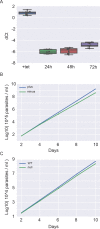The mRNA cap methyltransferase gene TbCMT1 is not essential in vitro but is a virulence factor in vivo for bloodstream form Trypanosoma brucei
- PMID: 30040830
- PMCID: PMC6057678
- DOI: 10.1371/journal.pone.0201263
The mRNA cap methyltransferase gene TbCMT1 is not essential in vitro but is a virulence factor in vivo for bloodstream form Trypanosoma brucei
Abstract
Messenger RNA is modified by the addition of a 5' methylated cap structure, which protects the transcript and recruits protein complexes that mediate RNA processing and/or the initiation of translation. Two genes encoding mRNA cap methyltransferases have been identified in T. brucei: TbCMT1 and TbCGM1. Here we analysed the impact of TbCMT1 gene deletion on bloodstream form T. brucei cells. TbCMT1 was dispensable for parasite proliferation in in vitro culture. However, significantly decreased parasitemia was observed in mice inoculated with TbCMT1 null and conditional null cell lines. Using RNA-Seq, we observed that several cysteine peptidase mRNAs were downregulated in TbCMT1 null cells lines. The cysteine peptidase Cathepsin-L was also shown to be reduced at the protein level in TbCMT1 null cell lines. Our data suggest that TbCMT1 is not essential to bloodstream form T. brucei growth in vitro or in vivo but that it contributes significantly to parasite virulence in vivo.
Conflict of interest statement
The authors have declared that no competing interests exist.
Figures



Similar articles
-
Characterization of a Trypanosoma brucei RNA cap (guanine N-7) methyltransferase.RNA. 2006 Mar;12(3):488-97. doi: 10.1261/rna.2250606. Epub 2006 Jan 23. RNA. 2006. PMID: 16431985 Free PMC article.
-
Trypanosoma brucei encodes a bifunctional capping enzyme essential for cap 4 formation on the spliced leader RNA.J Biol Chem. 2007 Jun 1;282(22):15995-6005. doi: 10.1074/jbc.M701569200. Epub 2007 Apr 6. J Biol Chem. 2007. PMID: 17416901
-
Role of the Trypanosoma brucei natural cysteine peptidase inhibitor ICP in differentiation and virulence.Mol Microbiol. 2007 Nov;66(4):991-1002. doi: 10.1111/j.1365-2958.2007.05970.x. Epub 2007 Oct 17. Mol Microbiol. 2007. PMID: 17944830 Free PMC article.
-
Regulation of antigen gene expression in Trypanosoma brucei.Trends Parasitol. 2005 Nov;21(11):517-20. doi: 10.1016/j.pt.2005.08.016. Epub 2005 Aug 29. Trends Parasitol. 2005. PMID: 16126458 Review.
-
Parasite-driven pathogenesis in Trypanosoma brucei infections.Parasite Immunol. 2011 Aug;33(8):448-55. doi: 10.1111/j.1365-3024.2011.01286.x. Parasite Immunol. 2011. PMID: 21366624 Free PMC article. Review.
Cited by
-
Trypanosome mRNA recapping is triggered by hypermethylation originating from cap 4.Nucleic Acids Res. 2024 Sep 23;52(17):10645-10653. doi: 10.1093/nar/gkae614. Nucleic Acids Res. 2024. PMID: 39011881 Free PMC article.
-
Genomewide Analysis of Mode of Action of the S-Adenosylmethionine Analogue Sinefungin in Leishmania infantum.mSystems. 2019 Oct 15;4(5):e00416-19. doi: 10.1128/mSystems.00416-19. mSystems. 2019. PMID: 31615876 Free PMC article.
-
mRNA cap regulation in mammalian cell function and fate.Biochim Biophys Acta Gene Regul Mech. 2019 Mar;1862(3):270-279. doi: 10.1016/j.bbagrm.2018.09.011. Epub 2018 Oct 9. Biochim Biophys Acta Gene Regul Mech. 2019. PMID: 30312682 Free PMC article. Review.
References
-
- Sbicego S, Vassella E, Kurath U, Blum B, Roditi I. The use of transgenic Trypanosoma brucei to identify compounds inducing the differentiation of bloodstream forms to procyclic forms. Molecular and biochemical parasitology. 1999. November 30;104(2):311–22. . - PubMed
-
- Van Den Abbeele J, Claes Y, van Bockstaele D, Le Ray D, Coosemans M. Trypanosoma brucei spp. development in the tsetse fly: characterization of the post-mesocyclic stages in the foregut and proboscis. Parasitology. 1999. May;118 (Pt 5):469–78. . - PubMed
-
- Johnson PJ, Kooter JM, Borst P. Inactivation of transcription by UV irradiation of T. brucei provides evidence for a multicistronic transcription unit including a VSG gene. Cell. 1987. October 23;51(2):273–81. . - PubMed
-
- Mottram JC, Murphy WJ, Agabian N. A transcriptional analysis of the Trypanosoma brucei hsp83 gene cluster. Molecular and biochemical parasitology. 1989. November;37(1):115–27. . - PubMed
Publication types
MeSH terms
Substances
Grants and funding
LinkOut - more resources
Full Text Sources
Other Literature Sources
Miscellaneous

